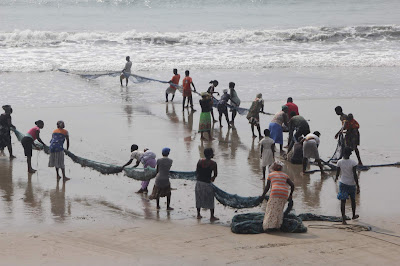Why we celebrate World Oceans Day
What is World Ocean’s Day?
World
Oceans Day (WOD) serves as a reminder to every one of the importance of the
oceans in our daily lives. The oceans are our planet's lungs, as well as a
vital source of food and medicine.
 |
| Artisanal fishermen getting their daily food from the ocean |
The purpose of the celebration
The
goal of the Day is to raise public awareness about the impact of human actions
on the ocean, to build a global citizen movement for the ocean, and to mobilize
and unite the global population behind a project for the long-term management
of the world's oceans.
Why celebrate the World Ocean Day
We
are all connected, sustained, and supported by the oceans. Yet its health and
the well-being of all who depend on it are at a critical point. As the last
years have demonstrated, we must collaborate to develop a new balance with the
ocean that does not deplete its abundance but rather restores its vitality and
gives it new life. On June 8, 2022, the United Nations will celebrate World
Oceans Day with the theme,
“Revitalization:
Collective Action for the Ocean.”
Over ninety-five percent of the water on Earth is
found in the oceans, but tragically, climate change and pollution are putting
pressure on the oceans. Over 70% of the earth's surface is covered by water. It
is our source of life, providing food to humans and every other living thing on
the planet.
The ocean produces at least 50 percent of the planet's
oxygen and is home to the majority of the planet's species. It is the primary
source of protein for over a billion people worldwide. In addition, the ocean
is essential to our economy, with a projected 40 million jobs in ocean-based
businesses by 2030. Satellites are the major means of long-term, independent
observation of our huge ocean bodies and adjacent coastal zones. Ocean
monitoring is essential for the life of the planet.
Despite all of its benefits, the ocean currently needs
support.
With 90% of large fish populations reduced and 50% of coral reefs gone, humans are taking more from the ocean than it can sustain. To conserve and preserve the ocean and everything that it supports, we must establish a new balance based on an accurate understanding of the ocean and humanity's relationship with it. We must establish a connection to the oceans that is inclusive, innovative, and based on past experiences.
 |
| A call from UG-GMES to preserve the oceans |
How are satellites used for ocean observation?
In ways that are otherwise inconceivable, satellites
can "see" the sea. More than 70 percent of our planet's surface is
covered by the vast ocean, which can be observed by satellites. By remotely
sensing from orbits high above the Earth, satellites offer us with
significantly more information than would be feasible from the surface alone.
Using satellites, scientists examine the ocean in great detail. Satellites can collect information on ocean bathymetry, sea surface temperature, ocean colour, coral reefs, and sea and lake ice. Scientists also employ satellite data gathering systems to send signals from ground transmitters to researchers in the field, for purposes such as detecting tidal heights and whale migration. The information gathered remotely from emergency beacons is also utilized to save lives when individuals are in distress on boats, aeroplanes, or in remote locations.
Sea Surface Temperature
Knowing the temperature of the sea's surface can
inform scientists a great deal about the ocean's environment. Changes in
temperature alter the behaviour of fish, can lead to coral bleaching, and affect
the coastal climate. Images of sea surface temperature captured by satellites
also reveal patterns of water movement.
Sea Surface Colour
Additionally, satellites provide information regarding
the colour of the ocean. For instance, colour data assist researchers in
determining the impact of coastal flooding, detecting river plumes, and
locating dangerous algal blooms that can taint shellfish and kill other fish and
marine mammals. Satellite ocean colour data enables us to not only determine
where an algal bloom is starting, but also to forecast where it may travel in
the future.
 |
| A Potential Fishing Zone (PFZ) map using ocean colour |
Sea Level Change
One of the most significant potential impacts of
climate change is sea-level rise, which can lead to the flooding of coastal
areas and islands, the erosion of shorelines, and the destruction of vital
ecosystems such as wetland and mangrove habitats. The assessment of long-term
variations in the global mean sea level gives the means to test the global
warming forecasts of climate models.
Mapping
Oceanic features, such as coral reefs, can also be
mapped using satellite images. The geology of the sea floor is considerably
less complex than the geology of the continents since erosion rates are lower
and the continents have seen many collisions due to the opening and closure of
ocean basins.
Weather
The ocean has a significant role in regulating the
weather and climate of the world. Perhaps the most well-known application of
satellite technology is weather data.
 |
| Forecasting of ocean weather by GMES and Africa |
Tracking
Satellites that provide imagery of the environment may also be utilized in collaboration with other organizations that gather data from various sensors. For instance, marine species like sea turtles and manatees can be equipped with transmitters that send their locations to orbiting satellites. Similar technology is also utilized in human search and rescue operations.
GMES and Africa Project
To conserve the ocean and its resources for future
generations, the continental programme, Global Monitoring for Environment and
Security Project, intends to provide operational services, stimulate research
and create capacity for processes in the marine and coastal environment. It
emphasizes the application of technology and earth observation to policymaking
and the management of marine and coastal resources. In order to monitor the
environment as well as the ocean, Earth observation data is collected via
satellites or in situ around the globe.
The Marine and Coastal Areas Management in North and
West Africa (MarCNoWa) is one of the actions within the GMES and Africa
programme and is carried out by the University of Ghana's consortium. The
project encompasses 18 coastal nations in both West and North Africa (Algeria,
Benin, Cape Verde, Cote d'Ivoire, Egypt, Gambia, Ghana, Guinea Bissau, Guinea,
Liberia, Libya, Mauritania, Morocco, Nigeria, Senegal, Sierra Leone, Togo, and
Tunisia).
 |
| Staff and interns of the Regional Marine Centre, participated in a beach clean up to commemorate the day |
GMES and Africa is a joint program between the European Commission and the African Union Commission. GMES and Africa were created for the same reason as the European Copernicus Program: to support African organizations, policy-makers, and practitioners by providing Earth Observation data, products, and services, to develop relevant operational and actionable information, and to contribute to more effective and sustainable management of natural resources while combating climate change. The GMES and Africa program now offer a variety of applications in the following three thematic areas: (a) Long-Term Management of Natural Resources, (b) Marine and Coastal Areas, and (c) Water Resources Management.
The Action Plan
initiated a long-term structured dialogue between Africa and Europe on EO
systems to respond to global needs, manage the environment, comprehend and
mitigate the effects of climate change, and ensure civil security by providing
real-time information to policymakers, scientists, businesses, and the general
public. GMES & Africa encourages the development of local skills and
institutional, human, and technical resources for access to and use of EO-based
services for Africa's sustainable development on an operational basis.



Comments
Post a Comment